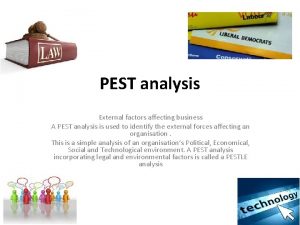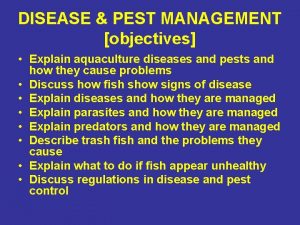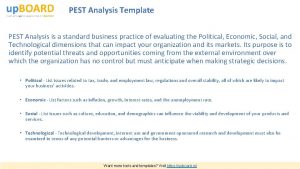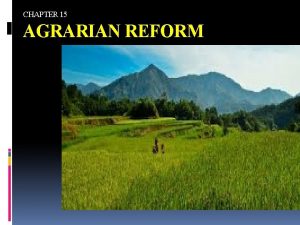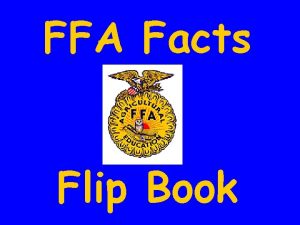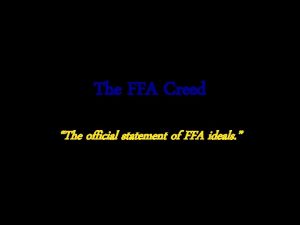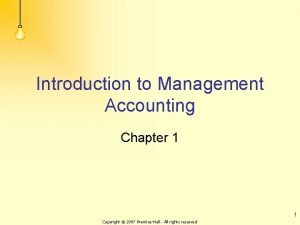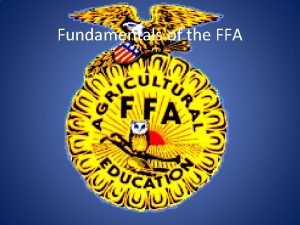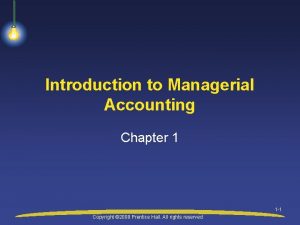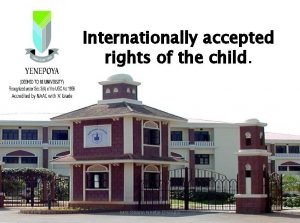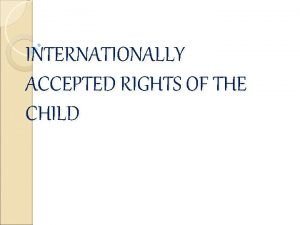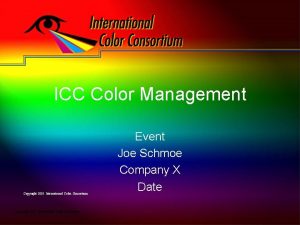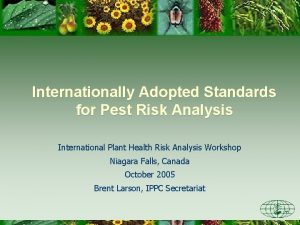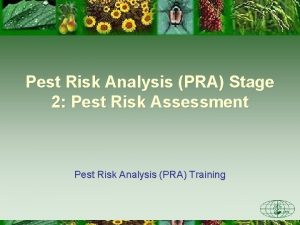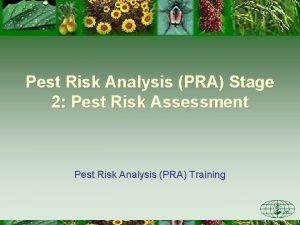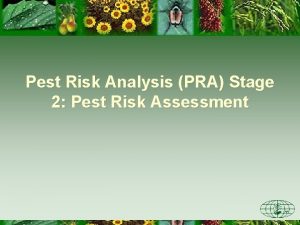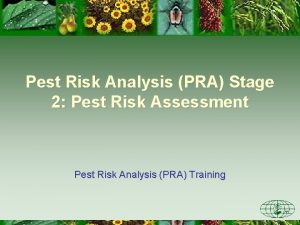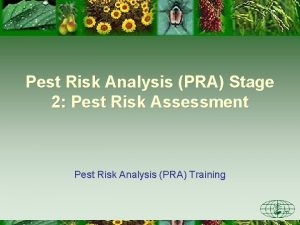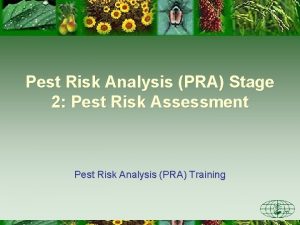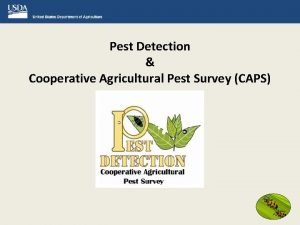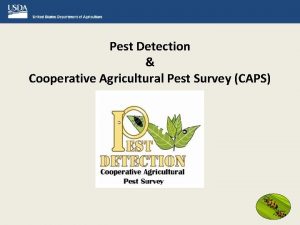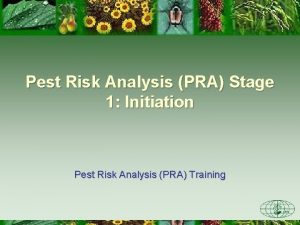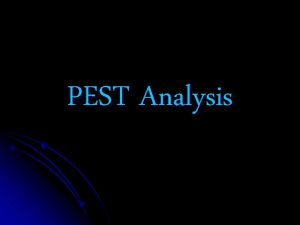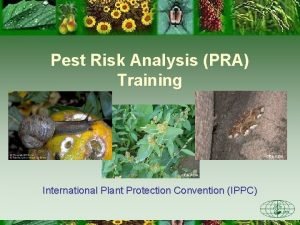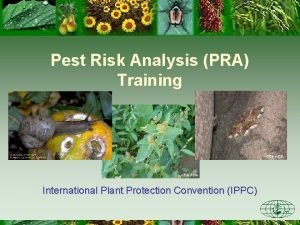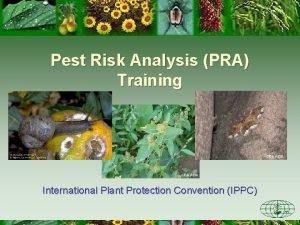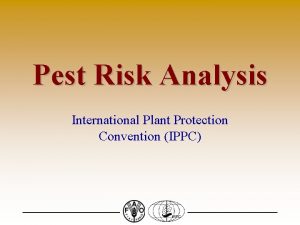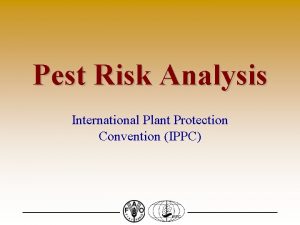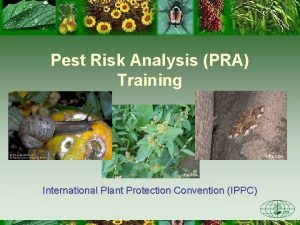Internationally Adopted Standards for Pest Risk Analysis International




























- Slides: 28

Internationally Adopted Standards for Pest Risk Analysis International Plant Health Risk Analysis Workshop Niagara Falls, Canada October 2005 Brent Larson, IPPC Secretariat

Outline • International Plant Protection Convention (IPPC) • International Standards for Phytosanitary Measures (ISPM) • Implications of the World Trade Organization Agreement on the Application of Sanitary and Phytosanitary Measures (SPS)

The IPPC • Multilateral treaty for international cooperation in plant protection • IPPC came into force in 1952 • Amendments to the IPPC – first in 1979 (accepted in 1991) – second in 1997 to align it with the SPS agreement (just accepted earlier this month)

Obligations from the Convention Article IV (4) of the IPPC • General provisions relating to the organizational arrangements for national plant protection – Each contracting party shall make provision, to the best of its ability, for an official national plant protection organization (NPPO) with the main responsibilities set out in this Article. – The responsibilities of an official national plant protection organization shall include the following: . . . . (f) the conduct of pest risk analyses;

Terms in the Convention related to PRA • Endangered area • Establishment • Introduction • Pest risk analysis • Regulated pest • Quarantine pest • Regulated nonquarantine pest • Technically justified

Terms in the Convention (cont. ) • Pest risk analysis - the process of evaluating biological or other scientific and economic evidence to determine whether a pest should be regulated and the strength of any phytosanitary measures to be taken against it;

Terms in the Convention (cont. ) • Regulated pest - a quarantine pest or a regulated non-quarantine pest; • Quarantine pest - a pest of potential economic importance to the area endangered thereby and not yet present there, or present but not widely distributed and being officially controlled; • Regulated non-quarantine pest - a nonquarantine pest whose presence in plants for planting affects the intended use of those plants with an economically unacceptable impact and which is therefore regulated within the territory of the importing contracting party;

Terms in the Convention (cont. ) • Technically justified - justified on the basis of conclusions reached by using an appropriate pest risk analysis or, where applicable, another comparable examination and evaluation of available scientific information.

ISPMs and PRA • ISPM No 1 - Principles of Plant Quarantine as Related to International Trade (1995) • ISPM No. 2 - Guidelines for Pest Risk Analysis (1996) • ISPM No. 3 – Guidelines for The Export, Shipment, Import and Release of Biological Control Agents and Other Beneficial Organisms (1996/2005) • ISPM No. 5 - Glossary of Phytosanitary Terms (2004) • ISPM No. 11 - Pest Risk Analysis for Quarantine Pests (2001), Including Analysis of Environmental Risks (2003) and Living Modified Organisms (2004) • ISPM No. 21 - Pest risk analysis for regulated non-quarantine pests (2004)

ISPM No. 1 – Principles of Plant Quarantine 11. Risk analysis • To determine which pests are quarantine pests and the strength of the measures to be taken against them, countries shall use pest risk analysis methods based on biological and economic evidence and, wherever possible, follow procedures developed within the framework of the IPPC. 12. Managed risk • Because some risk of the introduction of a quarantine pest always exists, countries shall agree to a policy of risk management when formulating phytosanitary measures.

ISPM No. 5 Glossary • Phytosanitary terms • Supplement No. 1 – Guidelines on the Interpretation and Application of the Concept of Official Control for Regulated Pests • Supplement No. 2 – Guidelines on the Understanding of Potential Economic Importance and Related Terms Including Reference to Environmental Considerations

ISPMs and PRA • ISPM No. 2 - Guidelines for Pest Risk Analysis (1996) • ISPM No. 11 - Pest Risk Analysis for Quarantine Pests (2001), Including Analysis of Environmental Risks (2003) and Living Modified Organisms (2004) • ISPM No. 21 - Pest risk analysis for regulated non-quarantine pests

ISPMs and PRA • ISPM No. 11 - Pest Risk Analysis for Quarantine Pests (2001), Including Analysis of Environmental Risks (2003) and Living Modified Organisms (2004) • ISPM No. 21 - Pest risk analysis for regulated non-quarantine pests

ISPMs and PRA • ISPM No. 11 - Pest Risk Analysis for Quarantine Pests (2001), Including Analysis of Environmental Risks (2003) and Living Modified Organisms (2004) – Supplements integrated into this standard additional criteria to consider when conducting PRA

Elements of PRA in ISPMs • • Stage 1: Initiation Stage 2: Pest Risk Assessment Stage 3: Pest Risk Management Monitoring and review of phytosanitary measures • Documentation • Risk Communication

Stage 1: Initiation • Triggered by one of the 3 Ps – Pathway – Pest – Policy • Determine if the organism is a pest, a pathway for a pest or has potential to be a pest or a pathway

Stage 2: Pest Risk Assessment • Pest Categorization – Quarantine Pest – Regulated Non-Quarantine Pest

Stage 2: Pest Risk Assessment (cont. ) • Probability of introduction (entry and establishment) and spread • Potential economic importance – direct and/or indirect

Stage 3: Pest Risk Management Consider: • Level of risk • Technical information • Acceptability of risk • Risk management options

Stage 3: Pest Risk Management (cont. ) Decision time • Based on the technical evidence presented and consideration of other factors (eg. political, social, cultural etc. ) a transparent risk management decision is taken

Monitoring and review of phytosanitary measures – adjust risk management options as additional information becomes available

Documentation • ensure records are kept of how decisions are taken including sources of information

Risk Communication • Not officially part of any IPPC standard but implicit • Tell people

Relationship to the SPS – members shall base their phytosanitary measures on international standards or justify deviations through risk analysis – members shall play a full part in the relevant standard setting organization – relevant standard setting organizations are Codex, OIE, and IPPC (Article 3 of the SPS, Harmonization)

Relationship to the SPS (cont. ) • IPPC is the phytosanitary standardsetting organization named in the WTOSPS Agreement • Under the IPPC, ISPMs are guidelines and not obligatory • Under the SPS, any phytosanitary measure based on an ISPM does not require additional technical justification

ISPM No. 2 – under review Wednesday Evening Session Aims of revision are to: • Introduce ‘hazard identification’ – as a step to establish whether a certain organism is a pest, prior to risk assessment • Hi-light types of organisms warranting hazard identification – in particular alien plants, beneficial organisms and LMOs

ISPM No. 2 – under review (cont. ) • Explain overall PRA concepts and the IPPC legal basis for carrying out PRA • Refer to relevant ISPMs for detailed guidance – particularly regarding stages 2 and 3 • Describe procedures generic to all PRA stages – i. e. information handling and risk communication

International Plant Protection Convention Secretariat Brent Larson, Food and Agriculture Organization of the United Nations Viale delle Terme di Caracalla 00100 Rome, ITALY www. ippc. int
 Credit risk market risk operational risk
Credit risk market risk operational risk Economic factors affecting tesco
Economic factors affecting tesco Aquaculture pest analysis
Aquaculture pest analysis Pest analysis template
Pest analysis template C-pest analysis for an event
C-pest analysis for an event Normal loss treatment in process costing
Normal loss treatment in process costing Author of the ffa creed
Author of the ffa creed Introduced the homestead system in the philippines. *
Introduced the homestead system in the philippines. * The method of unit costing is adopted by
The method of unit costing is adopted by Public law 740 passed by congress
Public law 740 passed by congress Ffa official dress
Ffa official dress Apollo hospital is
Apollo hospital is Who are responsible for curriculum development in pakistan
Who are responsible for curriculum development in pakistan I believe in less dependence on begging
I believe in less dependence on begging The institute of management accountants adopted the ______.
The institute of management accountants adopted the ______. Ffa creed 5th paragraph
Ffa creed 5th paragraph The method of unit costing is adopted by
The method of unit costing is adopted by Conventional representation of internal thread
Conventional representation of internal thread When was the ffa creed adopted and amended
When was the ffa creed adopted and amended The institute of management accountants adopted the ______.
The institute of management accountants adopted the ______. Unit 5: international business
Unit 5: international business Internationally accepted rights of the child pdf
Internationally accepted rights of the child pdf Internationally accepted rights of child
Internationally accepted rights of child Factors determining service standards
Factors determining service standards International property measurement standards
International property measurement standards International construction measurement standards
International construction measurement standards International colour consortium
International colour consortium International standards on drug use prevention
International standards on drug use prevention Reasons for accounting diversity
Reasons for accounting diversity

